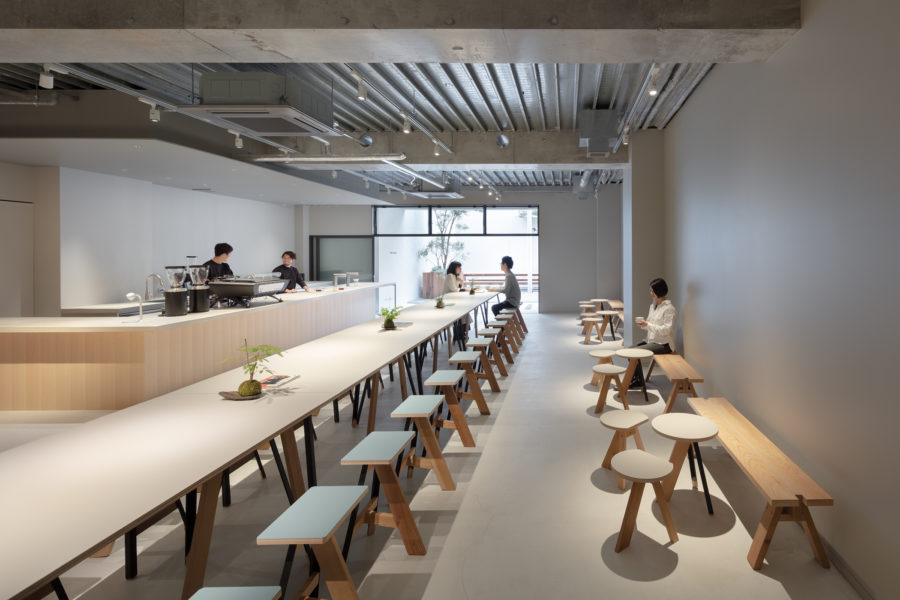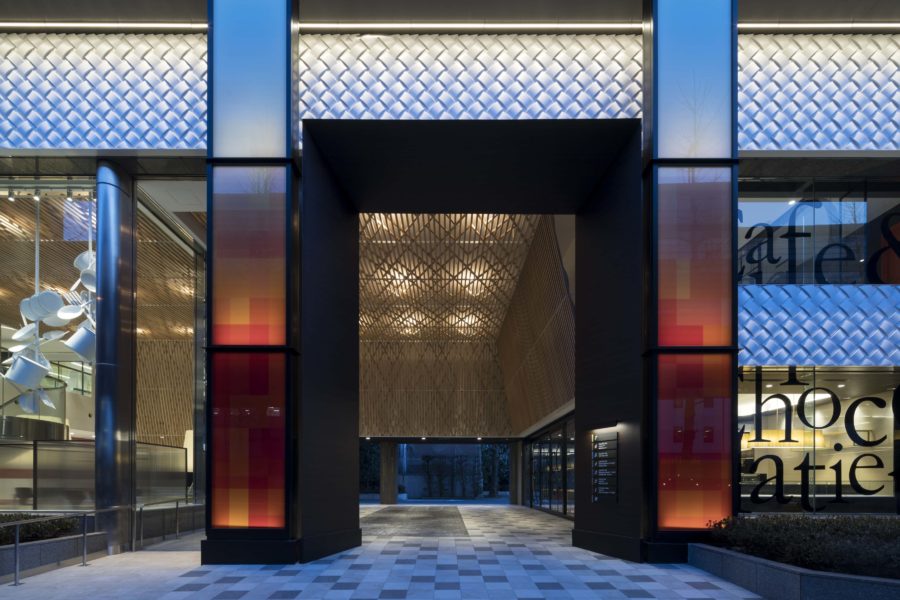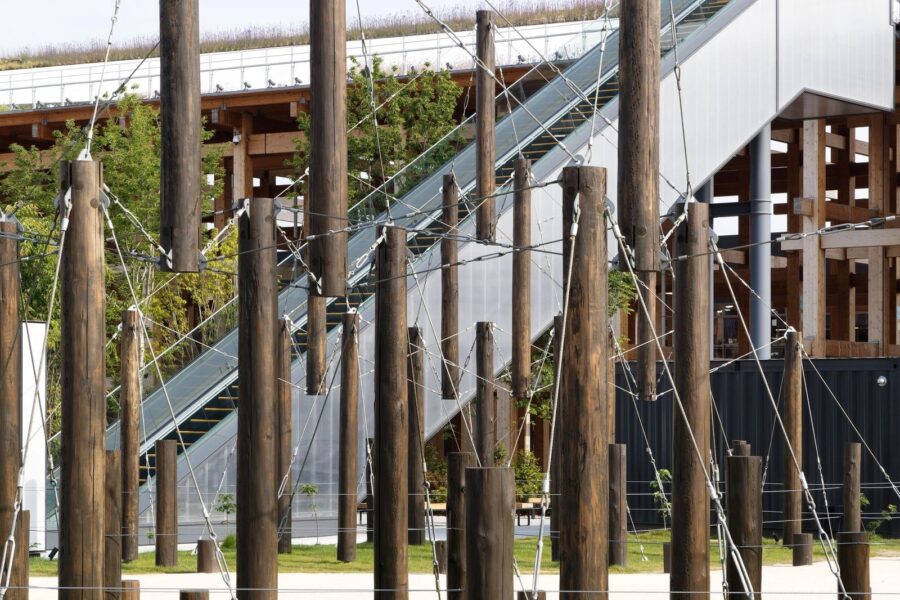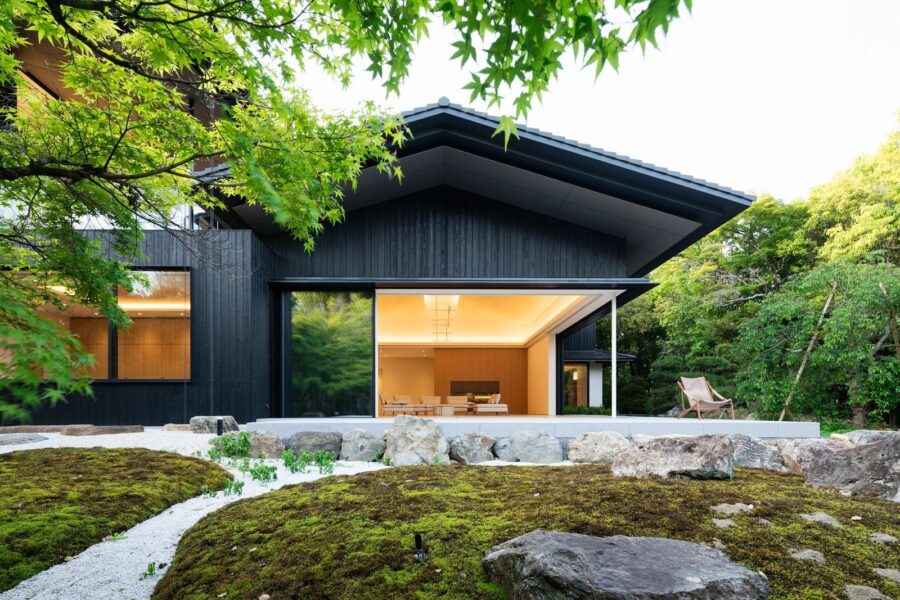ある科学誌(『Nature』2020年12月9日発表論文)で、「野放しに増え続ける人工物」という記事に出会った。それによると、人間の生み出した人工物が、今地球上の生物の質量を上回り始め、その大きな要因は建築資材なのだという。この内容は、これまでの「人のためだけの建築」をつくり続けることに限界が来ているということを示唆している。生物と人工物のバランスが臨界点にある今、これからの人間の居場所、建築のあり方とはどのようなものなのだろうか。
建築にはまず、厳しい自然から身を守るという本質的な機能が求められる。災害を経験するたび、自然と空間の境界は頑丈なものになり、人間と他生物の居場所の内外の分断はますます強くなっていった。われわれは、自然や他生物がつくり出す環境が、豊かであり美しいということはよく分かっている。だからこそ、庭に植栽をしたり、屋上や壁面に緑化を施したりする。しかし、建築の賑やかし、人の居場所のための添景としての植物は、人間側からの一方的な視点で計画されたものだ。それは、生き物としての居場所ではなく、拡張された人間の居場所のようなあり方である。「野放しに増え続ける人工物」の実態とは、実はこの「無意識に拡がっていく人間の居場所」にあるのではないだろうか。地球上で人も植物も動物も土中の虫たちもすべて生きるという事業をともに進めているのだから、大地は人も含むいろいろな生物が生息する不定形の集合体である。それらをひとつのまとまりとして、建築はその受け皿となれるのだろうか。
長屋の設計の依頼が来た。敷地は長閑な低層の住宅街であるが、目の前には豊かな自然公園が広がっている。天然記念物の植物群落も生息しながらも、観光客のボートが浮かぶ人工池もあり、自然と人工が織り交ざった環境である。敷地を人間のための居場所で埋め尽くすのではなく、目の前の環境を受け入れるような建築を模索した。通常は平面計画で敷地を「庭」と「家」に分配することが多いが、この方法だと自然と建築がただの近接関係になりがちだ。ならば、断面計画で「庭」と「家」を上下に積層していくとどうだろう。すべての階がグラウンドレベルとなり、その下にアンダーグラウンドのような空間が生まれ、相互に影響を与え合う関係が生まれそうだ。積層される庭は地被だけでなく、低木、中木までが混在する小さな森となるよう、土は極力深くした。それは、土の薄さを追求する現代の屋上緑化とは逆行している。庭を他生物にも開き、居場所として提供し、一緒につくっていくことで「庭」は「環境」になっていく。他生物を支える環境とするための必須条件は、土中の雨の良質な水はけにあった。そこで、雨水が重力で自然と落ちていく断面の検討を重ねた結果、連続ヴォールトスラブに行きついた。雨がヴォールトの山から谷へ、そして谷から縦にコアで運ばれるという水の流れが、そのまま建築の躯体のかたちとなった。このアプローチは、用水路やダムのような土木の設計と似ている。厳しい自然の中で、雨や土などをいかに合理的に背負い流していくか、それだけに集中する切実さが土木の設計にはある。事実、環境を背負うことは決して安易ではなかった。静的な人工物とは違い、環境の変化はコントロールできないからである。土はただでさえ重いのに、集中豪雨時の雨、年々成長し増大する植物、それらの荷重を見込み、予測不可能で不安定な生物や気候が建築の設計条件となったとき、一体何を基準にしたらよいのか。設計が進めば進むほど、環境を抱え込むことがとてつもなく怖くなった。それでも、豪雨に対応するオーバーフロー管を複数設けたり、抱え込む土を蒸散で日射熱をやわらげる効果のある内外の境界部分、屋上面や2階庇に限定し減量したり、自然のリスクにも向き合いなんとかこの「環境のインフラストラクチャー」は施工に至った。
なぜここまでしてこの「環境のための建築」をつくることにエネルギーを注いできたのか。それは「環境のための建築」が「人のための空間」にとっても新しい合理性をもたらすかもしれないという期待があったからだ。異常に厚い土が空間を包むことで、夏場は洞窟のように外部の日射熱を感じないほどひんやりと過ごせる居場所があったり、冬場は床暖房で土に蓄熱させ、床やコアの周囲にぼんやりと暖かい居場所があったり、土が人の暮らしにポジティブに働くかもしれない。また、雨を流すためにかたちづくられた連続ヴォールトスラブは、その下の空間に極端に天井高の低い部分を生み出し一見ネガティブにも思えるが、一般的なフラットスラブと比べ、もう少し生活に手を差し伸べる構造体のあり方になるかもしれない。頂点では3,500mmという開放的な高天井をつくりつつ、谷では2,000mmまで下がり手が届くスラブとなる。構造体に手が届けば、Pコンにアイボルト、リングナット、ワイヤーなどを取り付けて、自由な位置にハンモックをかけたり、ペンダントライトを移動したり、プランターを吊るしたり、カーテンで間仕切ったりできる。手に触れられる構造体は、生活に創造性を生み出してくれるかもしれない。環境だけでなく、暮らしも支える構造になる。
施工中も、まだ自分の中に大きな疑念が1つ残されていた。それは、この人工物に支えられた環境は、人の手の加わった「管理された自然」であり、本来の環境とは「手つかずの自然」のことを呼ぶのではないかということである。
そんなとき、学生時代、廃墟の調査でイタリア・ウルビーノの石積みの村を訪れた体験を思い出した。ぽっかりと開けた丘に廃墟があり、朽ちて大きな穴のある屋根をもつリビングであったであろう場所に入ってみると、驚いたことにその室内には小さな森があった。建築がなければあの場所はただの芝生の丘であった。しかし人間が構築した人工物の痕跡があったからこそ、明らかに生物は多様化していた。石の外壁があったから垂直面に自生できた蔦、屋根があったから強い日差しから守られた低木、床のタイルがあったから雨水を存分に受け生き延びた中木など、人工物のおかげで、環境の質に差が生まれ、多様な生物の居場所が提供されていたのだ。それを思い出したとき、このプロジェクトを通して「人間のための建築」は環境のためにもなり、「環境のための建築」は人間のためにもなるということを目指したいと感じた。人間と自然、土と植物、植物と動物、人間の暮らしの周囲にあるさまざまな生物同士の双方向から需要と供給を観察し、建築がそれぞれのもっている機能を結び付け、もちつもたれつの関係、相互補完の関係で成立する構成を見つけることができれば、これからの建ち方が獲得できるかもしれない。
〈鶴岡邸〉は、人だけでなく他生物も受け入れようと試みた建築となった。時間の経過と共に樹木は成長し、飛び交う鳥や虫も手伝って今ここにない樹種も加わり、やがて小さな森が生まれるかもしれない。数十年も経てば建築が姿を消すほどに生物が増大し、いつかは人工物の質量を超えていくに違いない。しかし、このひとつの住宅が広い地球環境を改善するほどの効果をもたらすわけではない。それよりも、生物と人工物の適切なバランスで構成された環境で、人と他生物が、私とあなたという2人称的な関係で、直接触れ合い、恵みをありがたく思える距離感で送れる生活、ただそれをつくりたかった。(武田清明)
A house that carries soil on its back, runs water, and accepts other living things
In a scientific journal (Nature: December 9, 2020), I came across an article titled “The Unchecked Growth of Artifacts. According to the article, human-made artifacts are now beginning to outnumber the mass of life on the planet, and a major factor in this is building materials. This suggests that we are reaching the limit of what we have been doing so far, which is to continue creating “architecture only for people. Now that the balance between living organisms and artifacts is critical, what is the future place for humans, and what is the ideal form of architecture?
First of all, architecture must have the essential function of protecting us from harsh nature. With each disaster, the boundary between nature and space has become sturdier, and the division between the inside and outside of the place of human beings and other living things has grown stronger. We know that the environment created by nature and other living things is rich and beautiful. We plant trees in our gardens, green rooftops, and walls. However, plants that add to the liveliness of architecture or serve as landscaping for people’s places are planned from a one-sided viewpoint on the human side. It is not a place for living creatures but a place for extended human beings. The reality of the “unchecked increase of artifacts” may lie in this “unconscious expansion of the human place. People, plants, animals, and insects on the earth are all engaged in the business of living together, and the earth is an amorphous aggregate inhabited by various organisms, including people. Can architecture serve as a receptacle for them as a single entity?
We were asked to design a row house. The site is a long, quiet, low-rise residential area, but a rich natural park stretches out in front of it. While a natural monumental plant colony is also present, there is also an artificial pond where tourists’ boats float, creating an environment where nature and artifice are interwoven. Rather than filling the site with places for humans, we sought to create an architecture that embraces the environment in front of it. Usually, the site is divided into a “garden” and a “house” in a plan, but this method tends to create a mere proximity relationship between nature and architecture. What if the “garden” and “house” were stacked vertically in a cross-sectional plan? All the floors would be at ground level, and an underground-like space would be created underneath, creating a relationship that mutually influences each other. The soil was made as deep as possible so that the stacked garden would be not only a ground level but also a small forest with a mixture of shrubs and even medium-sized trees. This is contrary to modern rooftop gardening, which pursues the thinness of soil. By opening the garden to other organisms, providing them with a place to live, and creating them together, the “garden” becomes an “environment. An essential condition for an environment that supports other organisms is good drainage of rainwater in the soil. Therefore, after repeated consideration of the cross section where rainwater naturally falls by gravity, we arrived at a continuous vault slab. The flow of water, as rain is carried from the mountains of the vault to the valley and from the valley to the vertical core, became the form of the architectural frame as it is. This approach is similar to civil engineering designs such as irrigation canals and dams. In civil engineering design, there is an earnestness to concentrate only on how to rationally carry rain, soil, and other elements in the harsh natural environment. It was never easy to take on the environment. Unlike static manufactured structures, changes in the environment cannot be controlled. Soil is heavy enough as it is, but when the design conditions of architecture are unpredictable and unstable creatures and the climate, with the prospect of torrential rains, plants that grow and increase in size every year, and other such loads, what exactly should the design criteria be? The more the design progressed, the more I became tremendously afraid of holding on to the environment. Nevertheless, we managed to construct this “environmental infrastructure” by installing multiple overflow pipes to cope with heavy rainfall, limiting the amount of soil to the boundary between the interior and exterior, the rooftop, and the second-floor eaves, where evaporation would soften the heat of solar radiation, and facing the risks of nature.
Why have we devoted so much energy to creating this “architecture for the environment”? I hoped “architecture for the environment” might bring new rationality to “space for people. By enveloping the space with unusually thick soil, there may be a place where people can spend their time in summer so coolly that they do not feel the heat from the outside sun, like a cave, or in winter, there may be a vaguely warm place around the floor and core by storing heat in the soil through floor heating. The soil may positively affect the lives of people. The continuous vaulted slab, which is shaped to shed rainwater, creates an extremely low ceiling height in the space below it, which may seem negative at first glance, but compared to a typical flat slab, it may be a way of structure that reaches out to people’s lives a little more. While creating an open high ceiling of 3,500mm at the apex, the slab drops to 2,000mm at the valley and can be reached. If the structure is reachable, eye bolts, ring nuts, and wires can be attached to the P-Con to hang hammocks in any position, move pendant lights, hanging planters, and partition the space with curtains. A structure that can be touched by hand may create creativity in our lives. The structure would support not only the environment but also the living.
During the construction, there was still one major doubt that remained in my mind. That is, the environment supported by this manufactured structure is “managed nature” with the addition of human hands, and the original environment is what we call “untouched nature.
This reminded me of an experience I had when I was a student visiting a masonry village in Urbino, Italy, as part of a survey of ruins. There was a ruin on an open hill, and when I entered what must have been a living room with a large hole in the roof, I was surprised to find a small forest inside the room. Without the architecture, the place would have been just a grassy hill. But because there were traces of manufactured structures, the creatures had diversified. Ivy could grow wild on the vertical surface because of the exterior stone wall, shrubs were protected from the strong sun because of the roof, and medium-sized trees survived because of the floor tiles that received rainwater to the fullest extent. When I remembered this, I felt that through this project, I wanted to aim at the fact that “architecture for human beings” is also for the environment, and “architecture for the environment” is also for human beings. If we can observe supply and demand from both sides, between humans and nature, soil and plants, plants and animals, and the various living things that surround us in our daily lives, and if we can find a structure in which architecture can combine the functions of each and be established in a mutually beneficial and complementary relationship, then we may be able to acquire the architectural style of the future. This project is an example of a building that is both a work of art and a residence.
The Tsuruoka Residence is an architecture that attempts to accommodate people and other living things. As time goes by, the trees will grow, and with the help of flying birds and insects, species of trees that are not here now will be added, and eventually, a small forest may be born. In a few decades, the organisms will grow to such an extent that the architecture will disappear, and one day it will surely exceed the mass of manufactured objects. However, this single house will not have enough effect to improve the global environment at large. Rather, I wanted to create a life in which people and other living creatures are in direct contact with each other in a second-person “I and you” relationship, in an environment composed of an appropriate balance of living creatures and manufactured objects, and at a distance that makes us feel grateful for the blessings we receive. (Kiyoaki Takeda)
【鶴岡邸】
所在地:東京都練馬区
用途:長屋
クライアント:個人
竣工:2020年
設計:株式会社武田清明建築設計事務所
担当:武田清明、作山美幸
構造設計:鈴木 啓(ASA)、長谷川理男(ASA元所員・oha代表)
照明:竹内俊雄
植栽:太田敦雄、松島哲雄(ACID NATURE)
施工:株式会社太平建設
家具:南川英雄(株式会社サインクラフト)
造園:上田 亮、新保博巨(越後苔匠)
撮影:浜田昌樹(kkpo)
工事種別:新築
構造:鉄骨造
規模:地上2階
敷地面積:258.27m²
建築面積:111.59m²
延床面積:206.72m²
設計期間:2018.10-2020.04
施工期間:2020.06-2021.06
【Tsuruoka house】
Location: Nerima-ku, Tokyo
Principal use: Tenement house
Client: Individual
Completion: 2020
Architects: Kiyoaki Takeda architects
Design team: Kiyoaki Takeda, Miyuki Sakuyama
Structure engineer: Akira Suzuki / ASA
Lighting: Toshio Takeuchi
Landscape: Atsuo Ota, Tetsuo Matsushima / ACID NATURE
Contractor: Taihei Kensetsu
Furniture: Hideo Minamikawa (Sign Craft Co., Ltd.)
Landscaping: Ryo Ueda, Hiroki Shinbo (Echigo kokesho)
Photographs: Masaki Hamada / kkpo
Construction type: New Building
Main structure: Steel
Building scale: 2 stories
Site area: 258.27m²
Building area: 111.59m²
Total floor area: 206.72m²
Design term: 2018.10-2020.04
Construction term: 2020.06-2021.06








